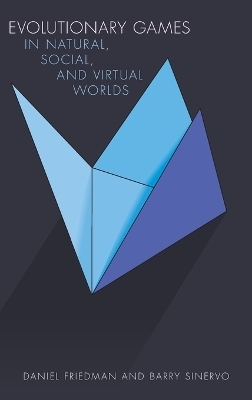
Evolutionary Games in Natural, Social, and Virtual Worlds
Oxford University Press Inc (Verlag)
978-0-19-998115-1 (ISBN)
Over the last 25 years, evolutionary game theory has grown with theoretical contributions from the disciplines of mathematics, economics, computer science and biology. It is now ripe for applications. In this book, Daniel Friedman---an economist trained in mathematics---and Barry Sinervo---a biologist trained in mathematics---offer the first unified account of evolutionary game theory aimed at applied researchers. They show how to use a single set of tools to build useful models for three different worlds: the natural world studied by biologists; the social world studied by anthropologists, economists, political scientists and others; and the virtual world built by computer scientists and engineers.
The first six chapters offer an accessible introduction to core concepts of evolutionary game theory. These include fitness, replicator dynamics, sexual dynamics, memes and genes, single and multiple population games, Nash equilibrium and evolutionarily stable states, noisy best response and other adaptive processes, the Price equation, and cellular automata. The material connects evolutionary game theory with classic population genetic models, and also with classical game theory. Notably, these chapters also show how to estimate payoff and choice parameters from the data.
The last eight chapters present exemplary game theory applications. These include a new coevolutionary predator-prey learning model extending rock-paper-scissors; models that use human subject laboratory data to estimate learning dynamics; new approaches to plastic strategies and life cycle strategies, including estimates for male elephant seals; a comparison of machine learning techniques for preserving diversity to those seen in the natural world; analyses of congestion in traffic networks (either internet or highways) and the "price of anarchy "; environmental and trade policy analysis based on evolutionary games; the evolution of cooperation; and speciation. As an aid for instruction, a web site provides downloadable computational tools written in the R programming language, Matlab, Mathematica and Excel.
Daniel Friedman is Distinguished Professor of Economics at the University of California, Santa Cruz. The author of over 100 articles and 5 previous books, his work has appeared in leading academic journals in economics, finance, and psychology. He is founder and director of LEEPS lab which conducts human subject experiments in market and strategic interaction, supported by 14 National Science Foundation grants along with grants from IBM, HP labs, Google, and Environmental Defense. Barry Sinervo, Full Professor, University of California, Santa Cruz, is an evolutionary biologist who conducts research on Behavioral Ecology, Game Theory and the Biotic Impacts of Climate Change. He has authored over 100 peer-reviewed publications. In addition to his research in game theory, he is currently researching contemporary extinctions of reptiles and amphibians and changes in plant communities driven by climate change, at sites distributed on five continents, leading a multinational research team of scientists developing physiological models of the biotic impacts of climate change on diverse biological systems, and measuring the biotic impacts of climate from equatorial sites to polar regions. He is also Director of the UC-wide Institute for the Study of the Ecological and Evolutionary Climate Impacts, a research consortium funded by a UC Presidential Research Catalyst Award.
PART I: BASICS
1. Population Dynamics
1.1 Fitness
1.2 Tradeoffs and Fitness Dependence
1.3 Dependence on environment, density and frequency
1.4 State space geometry
1.5 Memes and Genes
1.6 Finite populations and randomness
1.7 Replicator dynamics in discrete time
1.8 Replicator dynamics in continuous time
1.9 Steady states and stability
1.10 Sexual dynamics
1.11 Discussion
1.12 Appendix A: Derivation of the Fisher equation
1.13 Appendix B. Replicator dynamics, mean fitness, and entropy
1.14 Exercises
1.15 Endnotes
1.16 Bibliography
2. Simple Frequency Dependence
2.1 The Hawk-Dove game
2.2 H-D parameters and dynamics
2.3 The three kinds of 2x2 games .
2.4 Dilemmas played by viruses and eBay sellers
2.5 Nonlinear frequency dependence
2.6 RPS and the simplex
2.7 Replicator dynamics for RPS
2.8 Discussion
2.9 Appendix A. Payoff differences in 3x3 games
2.10 Exercises
2.11 Endnotes
2.12 Bibliography
3. Dynamics in n-dimensional Games
3.1 Sectoring the 2-d simplex
3.2 Estimating 3x3 payoff matrices
3.3 More strategies
3.4 Nonlinear frequency dependence
3.5 Two population games: the square
3.6 Hawk-Dove with two populations
3.7 Own population effects
3.8 Higher dimensional games
3.9 Alternative dynamics
3.10 Discussion
3.11 Appendix: Estimating 3x3 payoff matrices
3.12 Exercises
3.13 Notes
3.14 Bibliography
4. Equilibrium
4.1 Equilibrium in 1 dimension
4.2 Nash equilibrium with n strategies
4.3 ESS with n strategies
4.4 Equilibrium in multi-population games
4.5 Fisherian runaway equilibrium
4.6 Discussion
4.7 Appendix A: Techniques to Assess Stability
4.8 Exercises
4.9 Notes
4.10 Bibilography
5. Social games
5.1 Assortative matching
5.2 Social Twists
5.3 Inheritance from two parents
5.4 The standard Price equation
5.5 Group-structured Price equation and cooperation
5.6 Group Structure and Assortativity in Lizards
5.7 Price Equation in Continuous Time
5.8 Discussion
5.9 Appendix: Equilibrium in the Kirkpatrick (1982) model
5.10 Exercises
5.11 Notes
5.12 Bibliography
6. Cellular Automaton Games
6.1 Specifying a CA
6.2 Prisoner's Dilemma
6.3 Snowdrift
6.4 Public goods games with two strategies
6.5 Spatial rock-paper-scissors dynamic
6.6 Application to bacterial strains
6.7 Buyer-seller game as a two population CA
6.8 Exercises
6.9 Notes
6.10 Bibliography
PART II: APPLICATIONS
7. Rock-Paper-Scissors Everywhere
7.1 Some RPS Theory
7.2 Humans Play RPS in the Lab
7.3 RPS Mating Systems
7.4 Predators Learn
7.5 A coevolutionary model of Predators and Prey
7.6 Discussion
7.7 Appendix
7.8 Exercises
7.9 Notes
7.10 Bibliography
8. Learning in Games
8.1 Perspectives on learning and evolution
8.2 An empirical example
8.3 Learning rules
8.4 Decision rules
8.5 Estimating a model
8.6 Results
8.7 Learning in Continuous Time .
8.8 Other Models of Learning
8.9 Open Frontiers
8.10 Appendix: Towards Models of Learning in Continuous Time
8.11 Exercises
8.12 Notes
8.13 Bibliography
9. Contingent Life Cycle Strategies
9.1 Hawks, Doves and Plasticity
9.2 Costly Plasticity
9.3 Classic Life Cycle Analysis
9.4 Strategic Life Cycle Analysis: Two Periods
9.5 Strategic Life Cycle Analysis: More general cases
9.6 Application: male elephant seals
9.7 Discussion
9.8 Appendix
9.9 Exercises
9.10 Notes
9.11 Bibliography
10. The Blessing and the Curse of the Multiplicative Updates (Contributed by Manfred K. Warmuth)
10.1 Demonstrating the blessing and the curse
10.2 Dispelling the curse
10.3 Discussion
10.4 Notes
10.5 Bibliography
11. Traffic Games (contributed by John Musacchio)
11.1 Simple Non-Atomic Traffic Games
11.2 Braess's Paradox
11.3 The Price of Anarchy with Nonlinear Latency Functions
11.4 Pigovian Taxes
11.5 Selfish Pricing
11.6 Circuit Analogy
11.7 Discussion
11.8 Exercises
11.9 Endnotes
11.10 Bibliography
12. International Trade and the Environment (contributed by Matthew McGinty)
12.1 Economics and evolutionary game theory
12.2 Static Cournot model
12.3 Green technology diffusion
12.4 International trade
12.5 International Trade and Pollution Taxation
12.6 Other Economic Applications
12.7 Exercises
12.8 Notes
12.9 Bibliography
13. Evolution of Cooperation
13.1 Coordination, cooperation and social dilemmas
13.2 Solution K: Kin Selection
13.3 Solution R: Bilateral reciprocity
13.4 Social preferences: a problematic solution
13.5 Early Human Niches
13.6 Solution M: Moral memes
13.7 Illustrative models
13.8 Prehistoric and historic moral codes
13.9 Discussion
13.10 Exercises
13.11 Notes
13.12 Bibliography
14. Speciation
14.1 Long run evolution
14.2 Adaptive Dynamics
14.3 Morph loss in RPS
14.4 Emergent Boundary Layers in Cellular Automata
14.5 Speciation in Social and Virtual Worlds
14.6 Discussion
14.7 Exercises
14.8 Endnotes
14.9 Bibliography
Glossaries
| Erscheinungsdatum | 19.03.2016 |
|---|---|
| Verlagsort | New York |
| Sprache | englisch |
| Maße | 155 x 236 mm |
| Gewicht | 794 g |
| Themenwelt | Mathematik / Informatik ► Mathematik ► Angewandte Mathematik |
| Mathematik / Informatik ► Mathematik ► Finanz- / Wirtschaftsmathematik | |
| Naturwissenschaften ► Biologie ► Evolution | |
| Wirtschaft ► Allgemeines / Lexika | |
| Wirtschaft ► Betriebswirtschaft / Management ► Allgemeines / Lexika | |
| Wirtschaft ► Volkswirtschaftslehre ► Ökonometrie | |
| ISBN-10 | 0-19-998115-9 / 0199981159 |
| ISBN-13 | 978-0-19-998115-1 / 9780199981151 |
| Zustand | Neuware |
| Informationen gemäß Produktsicherheitsverordnung (GPSR) | |
| Haben Sie eine Frage zum Produkt? |
aus dem Bereich


